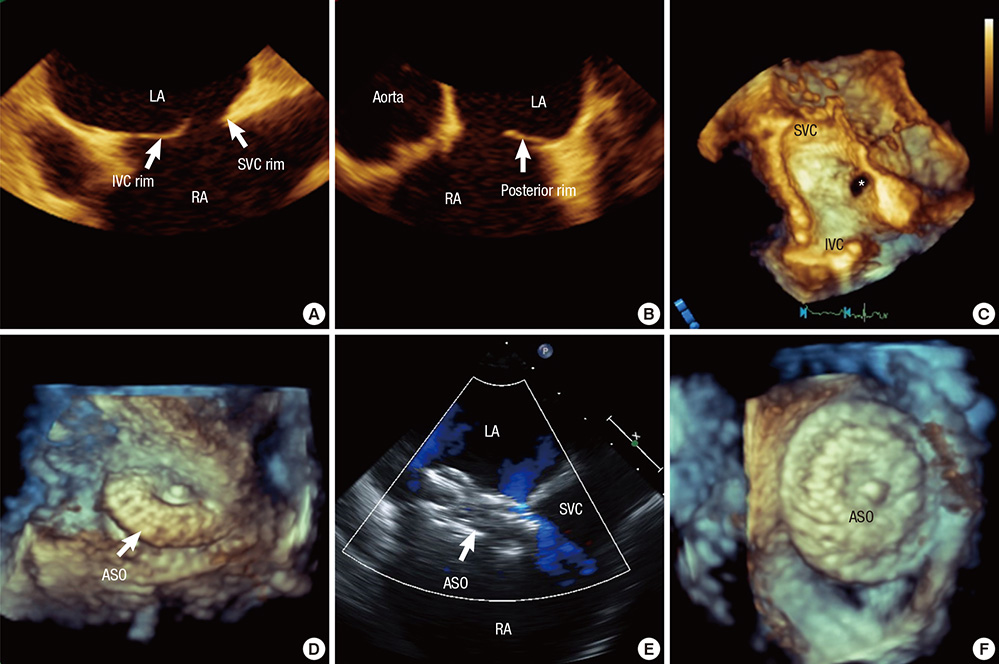J Korean Med Sci.
2014 Jun;29(6):871-873. 10.3346/jkms.2014.29.6.871.
Percutaneous Retrieval and Redeployment of an Atrial Septal Occluder under Three-Dimensional Transesophageal Echocardiographic Guidance: A Case Report
- Affiliations
-
- 1Department of Cardiology, Medical Research Institute, Pusan National University Hospital, Busan, Korea. jhoh724@hanmail.net
- KMID: 1796953
- DOI: http://doi.org/10.3346/jkms.2014.29.6.871
Abstract
- Percutaneous device closure for secundum atrial septal defects (ASDs) has been performed commonly and safely with high success rates. However, it is still challenging to close ASDs that are surrounded with deficient or hypermobile rims and could be compromised with an unexpected migration of device. We report a case of percutaneous Amplazter Septal Occluder (ASO; St. Jude Medical Inc., St. Paul, Minnesota, USA) device closure for an ASD with a thin and floppy interatrial septum, which immediately migrated into the right atrium and was not pulled back into the delivery sheath. To our knowledge, this is the first report on a successful percutaneous retrieval and redeployment of the device in such a situation, preventing any vascular injury or unplanned emergency open heart surgery.
Keyword
MeSH Terms
Figure
Reference
-
1. Chessa M, Carminati M, Butera G, Bini RM, Drago M, Rosti L, Giamberti A, Pomè G, Bossone E, Frigiola A. Early and late complications associated with transcatheter occlusion of secundum atrial septal defect. J Am Coll Cardiol. 2002; 39:1061–1065.2. Du ZD, Hijazi ZM, Kleinman CS, Silverman NH, Larntz K. Amplatzer Investigators. Comparison between transcatheter and surgical closure of secundum atrial septal defect in children and adults: results of a multicenter nonrandomized trial. J Am Coll Cardiol. 2002; 39:1836–1844.3. Losay J, Petit J, Lambert V, Esna G, Berthaux X, Brenot P, Angel C. Percutaneous closure with Amplatzer device is a safe and efficient alternative to surgery in adults with large atrial septal defects. Am Heart J. 2001; 142:544–548.4. Levi DS, Moore JW. Embolization and retrieval of the Amplatzer septal occluder. Catheter Cardiovasc Interv. 2004; 61:543–547.5. Pedra CA, Pedra SR, Esteves CA, Cassar R, Pontes SC Jr, Braga SL, Fontes VF. Transcatheter closure of secundum atrial septal defects with complex anatomy. J Invasive Cardiol. 2004; 16:117–122.6. Moore J, Hegde S, El-Said H, Beekman R 3rd, Benson L, Bergersen L, Holzer R, Jenkins K, Ringel R, Rome J, et al. Transcatheter device closure of atrial septal defects: a safety review. JACC Cardiovasc Interv. 2013; 6:433–442.7. Guimaraes M, Denton CE, Uflacker R, Schonholz C, Selby B Jr, Hannegan C. Percutaneous retrieval of an Amplatzer septal occluder device that had migrated to the aortic arch. Cardiovasc Intervent Radiol. 2012; 35:430–433.8. Goel PK, Kapoor A, Batra A, Khanna R. Transcatheter retrieval of embolized AMPLATZER Septal Occluder. Tex Heart Inst J. 2012; 39:653–656.
- Full Text Links
- Actions
-
Cited
- CITED
-
- Close
- Share
- Similar articles
-
- Amplatzer septal occluder found in the thoracic descending aorta by transesophageal echocardiography: A case report
- Horseshoe-like Shaped Atrial Septal Defects Confirmed on Three-Dimensional Transesophageal Echocardiography
- Percutaneous Retrieval of Embolized Amplatzer Septal Occluder after Treatment of Double Atrial Septal Defect: A Case Report
- The Operative Management of Embolized Septal Occluder at Ascending Aorta
- Echocardiographic Evaluation of Atrial Septal Defect Device Closure



